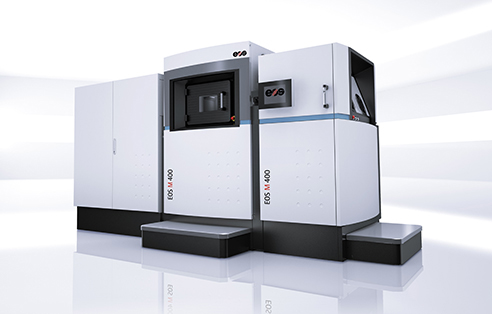EOS, the German market and technology leader for design-driven, integrated e-Manufacturing solutions for Additive Manufacturing (AM) is presenting the new EOS M 400 at this year’s Euromold (hall 11, stand E 148). A new system generation for the already established metal technology, this modular, extendable platform gears additive manufacturing up for application in industrial production environments. A number of factors contribute to this: The system enables the manufacture of larger components, productivity of this technology can move into new dimensions, and the level of automation is increased still further. In addition, the EOS M 400 delivers improved quality assurance and is made easier to use, thereby answering key requirements of our series production customers. The commercialization of the basic model begins in the spring of 2014, with the global distribution planned from the summer.
“EOS is pursuing a platform-based strategy for the metal technology and is able to support its customers from the research and development phase, through to the series production. The EOS M 400 represents the key to the industrial series utilization of Additive Manufacturing. If the EOSINT M 270 and EOSINT M 280 models have set the technical benchmarks, then the EOS M 400 takes these a step further. The new system supports users not only in the context of its qualification for production, but also in actual manufacturing applications. “We won’t be drawing the line at a single solution. We will be expanding the platform with successive performance modules”, says Adrian Keppler, Managing Director at EOS.
A modular system for new manufacturing dimensions
The EOS M 400 is based on a modular concept. The manufacturing solution is initially available with both set-up, and process stations. Within a year, an automated unpacking station will also be on offer. With this extension of the system, an exchangeable frame, including components and residual powder, is moved, following the build process, from the process station to the unpacking station. Here, the job will quickly be cleaned of all loose and excess powder by way of a clean-up program comprising rotation and vibration. The modular concept makes it possible to incorporate the unpacking station retroactively to expand on the set-up and process stations. Users thereby gain a future oriented e-manufacturing solution designed for application-specific, modular extension.
A further key innovation of the EOS M 400 is the volume of the building chamber, which measures 400x400x400 mm so that larger components can now be produced. This fact broadens the scope for new applications within the field of industrial series production. The first extension to the basic model, with its corresponding processes, will initially be offered with the EOS Aluminum AlSi10Mg and EOS NickelAlloy IN718 materials and is thereby particularly suited for use in the automobile and aerospace sectors. Processes for further materials are still in the development phase, including both tool steel and titanium.
Pilot customer Material Solutions: EOS M 400 opens the way for new product classes
EOS customer, Materials Solutions, based in the UK, acquired its first EOSINT M 270 metal system back in 2006. On the basis of this metal system the company developed its performance portfolio, covering the manufacture of high performance components and the further development of special alloys for engine manufacture. Today, the company has six EOSINT M 270 systems and a further EOSINT M 280 system is in the process of being acquired. Carl Brancher, CEO at Materials Solutions: “Our growth to date was only achievable thanks to this technology. Because of this, we’re particularly happy to act as a pilot customer and to test the new EOS M 400 system. The new system generation offers the possibility of developing entirely new product classes, such as applications for motor racing, or the production of titanium structures for air and space travel. The EOS M 400 enables the production of series components rather than just the simpler manufacture of functional models. The metal process is thus scalable and represents a revolution in series production. Now, larger high performance components can be created using Additive Manufacturing and these, at the same time, produced in larger quantities. We’re proud to be walking this road together with EOS.”
Whatever the application requirements: Manufacturing solutions with single/multiple lasers
In the EOS M 400 the laser has a performance of up to 1,000 watts. It allows the use of new materials that require more powerful lasers. A new user interface with touchscreen, developed out of talks with many customers, further simplifies the system usability. The complete handling has been optimized. Additionally, the filter from the air filtration system is automatically cleaned and has a significantly longer use-life. EOS has also further optimized both the monitoring and reporting functions, enabling the user to enjoy advancements in quality control. All of these innovations are aimed at meeting the requirements of series production and represent a further important step in making this a reality.
From 2015, EOS is planning to offer in addition to the EOS M 400 the EOS M 400-4 which will come with four lasers. While the single-laser version opens the way for the development of new applications, the focus of the multi-mode variant lies in achieving productivity increases of qualified production processes that have been already achieved for the EOSINT M 280.
Subscribe to our Newsletter
3DPresso is a weekly newsletter that links to the most exciting global stories from the 3D printing and additive manufacturing industry.





















